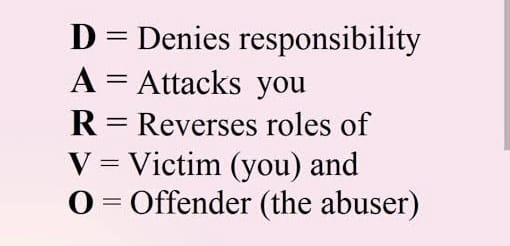Unmasking DARVO - The Manipulative Tactic Used by Narcissists and Abusers

What is DARVO?
DARVO is an acronym that stands for Deny, Attack, and Reverse Victim and Offender. It is a manipulative tactic used by narcissists and abusers to deflect blame and avoid accountability when confronted with their wrongdoing.
Understanding the DARVO Response
When perpetrators are confronted with their harmful behavior, they often employ the DARVO tactic to shift the focus away from their actions and onto the victim. This response is a common reaction of individuals who are unwilling to take responsibility for their behavior.
Breaking Down the DARVO Tactic
The DARVO tactic involves three key components:
- Deny: The perpetrator denies any wrongdoing, even when faced with evidence or proof of their actions.
- Attack: The perpetrator attacks the victim, often by questioning their credibility, sanity, or motives.
- Reverse Victim and Offender: The perpetrator portrays themselves as the victim and the actual victim as the offender, effectively reversing the roles.
This manipulative tactic is used to confuse and disorient the victim, making it difficult for them to seek justice or support.
How Does DARVO Work?
DARVO is a manipulative tactic used by narcissists and abusers to evade accountability and shift the focus away from their own wrongdoing. The acronym stands for Deny, Attack, Reverse Victim and Offender. Here's a detailed breakdown of how DARVO works:
Deny: The Perpetrator Denies Any Wrongdoing or Responsibility
The perpetrator's initial response to accusations is to deny any wrongdoing or responsibility. This denial can be outright, or it may involve downplaying or trivializing the severity of their actions. By denying any wrongdoing, the perpetrator attempts to create doubt and uncertainty, making it difficult for others to discern the truth.
Attack: The Perpetrator Attacks the Victim
When denial is not enough, the perpetrator shifts to attacking the victim. This can involve accusations, blame-shifting, or even outright threats. The goal is to silence the victim, discredit their claims, and turn the tables to make the victim appear as the aggressor. This attack can be verbal, emotional, or even physical.
Reverse Victim and Offender: The Perpetrator Portrays Themselves as the Victim
In the final stage of DARVO, the perpetrator attempts to reverse the roles of victim and offender. They portray themselves as the victim of the actual victim's alleged wrongdoing. This can involve fabricating stories, manipulating facts, or exploiting emotions to gain sympathy and support from others. By doing so, the perpetrator aims to avoid accountability and maintain control over the situation.
The Impact of DARVO
DARVO, a manipulative tactic used by narcissists and abusers, can have severe consequences on the victim's mental health and well-being. The effects of DARVO can be far-reaching and devastating, leading to long-lasting emotional distress.
Emotional Distress and Mental Health
DARVO can negatively impact the victim's mental health and well-being, leading to feelings of:
- Self-doubt: Victims may question their own perceptions, memories, and sanity.
- Anxiety: The constant denial and blame-shifting can create a sense of unease and apprehension.
- Depression: The emotional toll of DARVO can lead to feelings of hopelessness and despair.
Perpetuating a Cycle of Abuse
DARVO can also perpetuate a cycle of abuse and manipulation, making it challenging for victims to escape the toxic relationship. The abuser's tactics can:
- Reinforce their power and control
- Make the victim feel trapped and helpless
- Prevent the victim from seeking help and support
Breaking the Cycle
It's essential to recognize the signs of DARVO and seek support from trusted individuals, such as friends, family, or mental health professionals. Victims can:
- Document incidents and keep a record of events
- Seek validation and support from others
- Develop a safety plan to protect themselves from further abuse
How to Protect Yourself Against DARVO
Now that you know what DARVO is and how it's used by narcissists and abusers, it's essential to learn how to protect yourself from this manipulative tactic. Here are some steps you can take:
Educate Yourself on the DARVO Tactic and Its Signs
Knowledge is power, and understanding the DARVO tactic is crucial to recognizing when it's being used against you. Learn about the four components of DARVO - Deny, Attack, Reverse, and Victim-Blame - and be aware of the signs that someone is using this tactic on you. This will help you stay vigilant and not fall prey to their manipulation.
Stand Up for Yourself and Clearly Name What Is Happening
When someone uses DARVO against you, it's essential to stand up for yourself and clearly name what is happening. Use "I" statements to express your feelings and avoid blaming or attacking the other person. For example, "I feel gaslighted when you deny what happened" instead of "You're a liar." This helps to assert your experience without escalating the situation.
Seek Support from Trusted Individuals or Professionals
Don't try to handle the situation alone. Seek support from trusted friends, family, or professionals who can provide emotional support and guidance. Talking to someone who understands can help you process your feelings and develop a plan to protect yourself. Consider seeking the help of a therapist or counselor who specializes in narcissistic abuse or trauma.











Comments ()